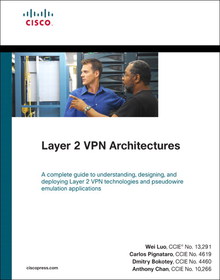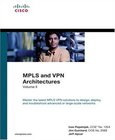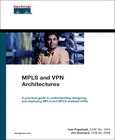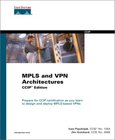Layer 2 VPN Architectures

Book Details:
| Publisher: | Cisco Press |
| Series: | Cisco Press |
| Author: | Wei Luo |
| Edition: | 1 |
| ISBN-10: | 1587051680 |
| ISBN-13: | 9781587051685 |
| Pages: | 648 |
| Published: | Mar 20 2005 |
| Posted: | Nov 19 2014 |
| Language: | English |
| Book format: | CHM |
| Book size: | 7.94 MB |
Book Description:
A complete guide to understanding, designing, and deploying Layer 2 VPN technologies and pseudowire emulation applications Evaluate market drivers for Layer 2 VPNs Understand the architectural frame-work and choices for Layer 2 VPNs, including AToM and L2TPv3 Grasp the essentials of Layer 2 LAN and WAN technologies Examine the theoretical and operational details of MPLS and LDP as they pertain to AToM Understand the theoretical and operational details of Layer 2 protocols over L2TPv3 in IP networks Learn about Layer 2 VPN bridged and routed interworking and Layer 2 local switching Understand the operation and application of Virtual Private LAN Services (VPLS) Learn about foundation and advanced AToM and L2TPv3 topics through an extensive collection of case studies The historical disconnect between legacy Layer 2 and Layer 3 VPN solutions has forced service providers to build, operate, and maintain separate infrastructures to accommodate various VPN access technologies. This costly proposition, however, is no longer necessary. As part of its new Unified VPN Suite, Cisco Systems now offers next-generation Layer 2 VPN services like Layer 2 Tunneling Protocol version 3 (L2TPv3) and Any Transport over MPLS (AToM) that enable service providers to offer Frame Relay, ATM, Ethernet, and leased-line services over a common IP/MPLS core network. By unifying multiple network layers and providing an integrated set of software services and management tools over this infrastructure, the Cisco Layer 2 VPN solution enables established carriers, IP-oriented ISP/CLECs, and large enterprise customers (LECs) to reach a broader set of potential VPN customers and offer truly global VPNs. Layer 2 VPN Architectures is a comprehensive guide to consolidating network infrastructures and extending VPN services. The book opens by discussing Layer 2 VPN applications utilizing both AToM and L2TPv3 protocols and comparing Layer 3 versus Layer 2 provider-provisioned VPNs. In addition to describing the concepts related to Layer 2 VPNs, this book provides an extensive collection of case studies that show you how these technologies and architectures work. The case studies include both AToM and L2TPv3 and reveal real-world service provider and enterprise design problems and solutions with hands-on configuration examples and implementation details. The case studies include all Layer 2 technologies transported using AToM and L2TPv3 pseudowires, including Ethernet, Ethernet VLAN, HDLC, PPP, Frame Relay, ATM AAL5 and ATM cells, and advanced topics relevant to Layer 2 VPN deployment, such as QoS and scalability.
Download Link:
Related Books:
MPLS and VPN Architectures Volume 2
Master the latest MPLS VPN solutions to design, deploy, and troubleshoot advanced or large-scale networks With MPLS and VPN Architectures, Volume II, you'll learn: How to integrate various remote access technologies into the backbone providing VPN service to many different types of customers The new PE-CE routing options as well as other advanced features, including per-VPN Network Address Translation (PE-NAT) How VRFs can be extended into a customer site to provide separation inside the customer network The latest MPLS VPN security features and designs aimed at protecting the MPLS VPN backbone How to carry customer multicast traffic inside a VPN The latest inter-carrier enhancements to allow for easier and more scalable deployment of inter-carrier ...
MPLS and VPN Architectures
A practical guide to understanding, designing, and deploying MPLS and MPLS-enabled VPNs In-depth analysis of the Multiprotocol Label Switching (MPLS) architecture Detailed discussion of the mechanisms and features that constitute the architecture Learn how MPLS scales to support tens of thousands of VPNs Extensive case studies guide you through the design and deployment of real-world MPLS/VPN networks Configuration examples and guidelines assist in configuring MPLS on Cisco devices Design and implementation options help you build various VPN topologies Multiprotocol Label Switching (MPLS) is an innovative technique for high-performance packet forwarding. There are many uses for this new technology, both within a service-provider environment and wit...
MPLS and VPN Architectures
Prepare for CCIP certification as you learn to design and deploy MPLS-based VPNsAssists in preparation for the CCIP MPLS elective exam with detailed technology coverage and review questionsOffers in-depth analysis of MPLS architectureHelps you learn how MPLS scales to support tens of thousands of virtual private networks (VPNs)Provides extensive case studies that guide you through the design and deployment of real-world MPLS/VPN networksPresents configuration examples and guidelines that assist you in configuring MPLS on Cisco devicesProvides design and implementation options that help you build various VPN topologiesMultiprotocol Label Switching (MPLS) is an innovative technique for high-performance packet forwarding. The most widely deployed usage ...
2007 - 2021 © eBooks-IT.org



